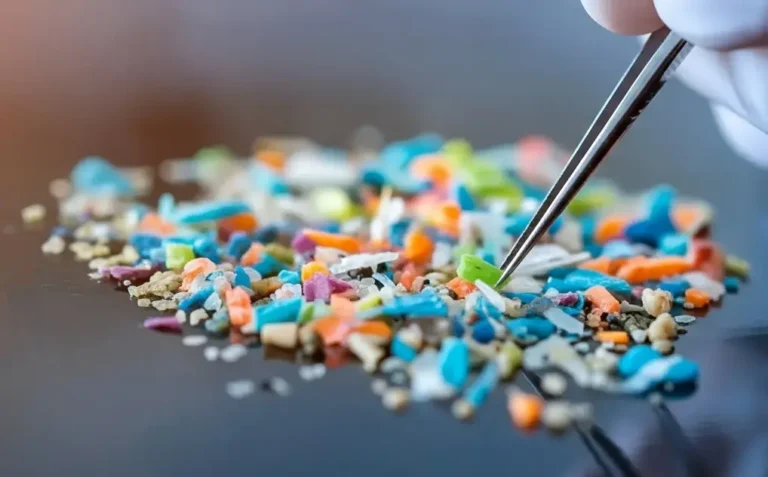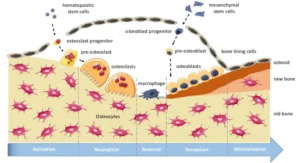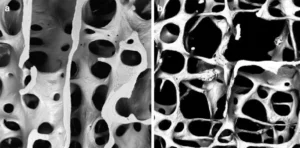Microplastics Bone Health Risk: Is Plastic Weakening Skeletons?
Tiny plastic fragments, found deep inside human bone, might be silently weakening our skeletons. Here's what the emerging science reveals.

Key Findings
- Microplastics have been directly discovered inside human bone and muscle tissue.
- Lab studies show these plastics disrupt bone cells, speeding up bone breakdown.
- They also harm the stem cells needed to build new bone.
- Animal studies link microplastic exposure to weaker bones, stunted growth, and deformities.
- Scientists suggest microplastics could be a new environmental risk factor for osteoporosis.
Primary Source
Source: Effects of microplastics on the bones: a comprehensive review
Author(s): Pelepenko, L.E., de Oliveira, M.C., Masaro, D.A. et al. (State University of Campinas, Brazil)
We face many global challenges today. Two big ones are the weakening of bones, called osteoporosis, and the massive amount of plastic pollution everywhere. Osteoporosis makes bones fragile and likely to break, affecting many older people. At the same time, tiny plastic pieces, called microplastics and nanoplastics (MNPs), have contaminated our entire planet. For a long time, we thought these problems were separate. Now, alarming new science suggests they might be connected inside our own bodies.
Researchers now think microplastics might not just be harmless debris. They might get into our tissues, even our bones. Once there, they could act as a new environmental trigger for bone diseases like osteoporosis. This idea is explored in a major scientific review paper.1Microplastics pose potential risks to bone health – News-Medical, accessed October 18, 2025, https://www.news-medical.net/news/20250918/Microplastics-pose-potential-risks-to-bone-health.aspx That paper gathered evidence from many studies to build the case.2Research Suggests Microplastics Could Be Weakening Your Bones, accessed October 18, 2025, https://www.ohiosap.org/aws/OSAP/pt/sd/news_article/603152/_blank/layout_details/false Let’s examine how this disturbing puzzle is coming together.
Wait, Plastic is Really Inside Our Bones?
Yes. The biggest shift came when scientists first found direct proof of microplastics inside human bone tissue.3New insights: Discovery of microplastics in human bone and skeletal muscle, accessed October 18, 2025, https://www.the-innovation.org/article/doi/10.59717/j.xinn-med.2024.100100 Before this, the idea was just a theory. Now, it is a documented fact.
A key study in 2024 looked at bone and muscle samples from patients getting joint replacements. Using a special light technique called Raman Spectrometry, they identified the materials’ molecules. The results were clear. They found microplastics in most bone samples and all muscle samples.4New insights: Discovery of microplastics in human … – The Innovation, accessed October 18, 2025, https://www.the-innovation.org/data/article/medicine/preview/pdf/XINNMEDICINE-2024-0141.pdf The amounts weren’t tiny either. They found dozens of particles per gram of tissue. This proved plastics can get into and build up in our musculoskeletal system.
What Kinds of Plastic Did They Find?
The study found several different types of plastic. These included common ones like Polypropylene (PP) from containers, Polyethylene (PE) from bags, and PET from bottles. They also found Polycarbonate (PC) and Polyurethane (PU) among others. Finding this mix suggests we are exposed constantly from many sources in our daily lives. It is not just one bad product. It is the breakdown of plastics all around us.
How Do Plastics Even Reach Our Bones?
How can plastic get deep inside solid bone? Humans mainly take in microplastics by eating contaminated food and water, or breathing dusty air. Our bodies get rid of larger particles. But very small microplastics, and especially tiny nanoplastics (smaller than 1 micrometer), can sneak through barriers in our gut or lungs.5Microplastics Research | US EPA, accessed October 18, 2025, https://www.epa.gov/water-research/microplastics-research
Once inside, they can travel through the bloodstream or lymphatic system.6Potential threats of environmental microplastics to the skeletal system: current insights and future directions – ResearchGate, accessed October 18, 2025, https://www.researchgate.net/publication/395513357_Potential_threats_of_environmental_microplastics_to_the_skeletal_system_current_insights_and_future_directions Bone marrow, the spongy tissue inside bones where blood cells are made, has a rich blood supply. It is a likely place for these traveling particles to settle.7Microplastics may affect bone health – Agência FAPESP, accessed October 18, 2025, https://agencia.fapesp.br/microplastics-may-affect-bone-health/55881 From the marrow, researchers believe the plastics might get trapped in the surrounding bone as it constantly repairs and rebuilds itself.
How Might Microplastics Damage Our Bones?
Finding plastic in bone is worrying. But the real concern is that these particles seem to interfere with how bones stay healthy. Our bones are constantly being renewed through a process called bone remodeling.8Bone remodeling – PubMed, accessed October 18, 2025, https://pubmed.ncbi.nlm.nih.gov/17308163/ Think of it like a never-ending road repair crew.
Two main cell types do this work:
- Osteoclasts: These are the demolition crew. They dissolve small bits of old or damaged bone.9Physiology, Bone Remodeling – StatPearls – NCBI Bookshelf, accessed October 18, 2025, https://www.ncbi.nlm.nih.gov/books/NBK499863/
- Osteoblasts: These are the builders. They come after the osteoclasts and lay down new bone material, which then hardens.10Osteoblasts & Osteoclasts: Function, Purpose & Anatomy – Cleveland Clinic, accessed October 18, 2025, https://my.clevelandclinic.org/health/body/24871-osteoblasts-and-osteoclasts
Healthy bones depend on a perfect balance between this demolition and construction. Osteoporosis happens when this balance is lost. Demolition (resorption) happens faster than building (formation), making bones weak and porous. Emerging evidence suggests microplastics severely disrupt this balance.

The bone remodeling cycle, showing the phases from activation to mineralization, involving osteoclasts, osteoblasts, and their precursor cells. Credit: ResearchGate.
Do Microplastics Speed Up Bone Demolition?
Yes, lab studies strongly suggest this. When bone precursor cells are exposed to microplastics, they are more likely to become bone-destroying osteoclasts. This process is called osteoclastogenesis.
How does this happen? The plastics trigger inflammation because cells see them as foreign invaders. This inflammation activates signaling pathways known as NF-κB and MAPK.11Potential threats of environmental microplastics to the skeletal system: current insights and future directions – PMC, accessed October 18, 2025, https://pmc.ncbi.nlm.nih.gov/articles/PMC12454088/ These signals are like alarm bells that, besides causing inflammation, also tell osteoclasts to form.
Worse still, microplastics can cause cellular senescence, which is like premature aging, in bone marrow stem cells. These aged stem cells then pump out excessive amounts of a protein called RANKL.12Chronic exposure to polystyrene microplastics triggers osteoporosis by breaking the balance of osteoblast and osteoclast differentiation – PubMed, accessed October 18, 2025, https://pubmed.ncbi.nlm.nih.gov/39608439/ RANKL is the main ‘go’ signal for making osteoclasts. So, microplastics effectively hit the accelerator on bone destruction.
Do Microplastics Also Slow Down Bone Building?
It seems so. New osteoblasts (the builders) come from special stem cells in the bone marrow called Bone Marrow Mesenchymal Stromal Cells (BMMSCs).13Bone Marrow Mesenchymal Stromal Cells: Identification, Classification, and Differentiation, accessed October 18, 2025, https://www.frontiersin.org/journals/cell-and-developmental-biology/articles/10.3389/fcell.2021.787118/full Research shows microplastics harm these critical stem cells.
One study exposed human BMMSCs to PET microplastics (from bottles).14Environmental microplastics (EMPs) exposure alter the … – PubMed, accessed October 18, 2025, https://pubmed.ncbi.nlm.nih.gov/35973457/ The exposed cells struggled to mature properly into bone-building cells. They produced less of the key markers needed for bone formation.15Environmental microplastics (EMPs) exposure alter the differentiation potential of mesenchymal stromal cells | Request PDF – ResearchGate, accessed October 18, 2025, https://www.researchgate.net/publication/362684689_Environmental_microplastics_EMPs_exposure_alter_the_differentiation_potential_of_mesenchymal_stromal_cells In simple terms, the microplastics sabotaged the construction crew needed for repairs.
What Other Damage Do They Cause?
Microplastics also create a generally unhealthy environment in the bone. They cause oxidative stress, an imbalance that damages cells.16Preliminary study on impacts of polystyrene microplastics on the hematological system and gene expression in bone marrow cells of mice – ResearchGate, accessed October 18, 2025, https://www.researchgate.net/publication/351333121_Preliminary_study_on_impacts_of_polystyrene_microplastics_on_the_hematological_system_and_gene_expression_in_bone_marrow_cells_of_mice This stress and the chronic inflammation both favor bone breakdown over building. The premature aging (senescence) also makes cells release harmful substances, creating a vicious cycle of damage. Plus, studies show microplastics can simply make bone cells less healthy and more likely to die.
Does This Happen in Living Animals Too?
Yes. Studies on animals like mice, rats, and fish confirm the lab findings. Animals that ingested microplastics showed real skeletal problems.
Young animals exposed to microplastics experienced stunted growth and skeletal deformities.17The Effects of Microplastics on Musculoskeletal Disorder; A…, accessed October 18, 2025, https://pmc.ncbi.nlm.nih.gov/articles/PMC11775366/ Rodrigo Bueno de Oliveira, lead author of the main review, noted that some studies showed growth stopping entirely.18agencia.fapesp.br, accessed October 18, 2025, https://agencia.fapesp.br/microplastics-may-affect-bone-health/55881#:~:text=For%20example%2C%20in%20vitro%20studies,in%20Nephrology%20(LEMON)%20at%20the Advanced scans (micro-CT) revealed damage inside the bones of adult mice. Their bone microstructure looked destroyed, with fewer internal supports (trabeculae) and less overall bone mass, similar to osteoporosis. Blood tests also showed disrupted levels of calcium and phosphorus, key minerals for bone health. Some studies even found lower white blood cell counts, suggesting damage to the bone marrow itself.19Effects of microplastics on the bones: a comprehensive review – ResearchGate, accessed October 18, 2025, https://www.researchgate.net/publication/392969735_Effects_of_microplastics_on_the_bones_a_comprehensive_review

Microscopic comparison of bone structure. (a) Normal, dense trabecular bone. (b) Osteoporotic bone showing thinner, less connected trabeculae and larger pores. Credit: ResearchGate.
Why Does This Potential Link Matter So Much?
This research connects two huge global issues: the rising rates of osteoporosis in aging populations and the flood of plastic waste. Osteoporosis already affects hundreds of millions, causing painful fractures.20Doctors Find Evidence That Microplastics Are Degrading Your Bones – Yahoo News NZ, accessed October 18, 2025, https://nz.news.yahoo.com/doctors-evidence-microplastics-degrading-bones-173000589.html Finding a *new*, potentially widespread environmental risk factor could change how we view and prevent this disease.
For decades, osteoporosis prevention focused on factors like age, genetics, diet, and exercise. If microplastics are confirmed as a significant contributor, it adds a major environmental piece to the puzzle. This shifts some responsibility from individual lifestyle choices towards societal action on plastic pollution. We might need policies to reduce plastic production and waste, similar to actions taken against lead in gasoline or air pollution.
What Are the Limitations and Next Steps?
It is important to be scientifically cautious. While the evidence is strong, we haven’t yet proven a direct causal link between typical human exposure levels and overall osteoporosis rates. Lab and animal studies often use higher plastic concentrations than people currently experience.21Microplastics may disrupt bone remodeling and blood cell formation, potentially raising risk for osteoporosis and other bone disorders. Digest – FoundMyFitness, accessed October 18, 2025, https://www.foundmyfitness.com/stories/s24rt6 Osteoporosis is complex, with many contributing factors. Figuring out the exact role of microplastics is challenging.
Researchers are working hard to fill these gaps. Oliveira’s team is planning new animal studies. They will directly measure bone strength after microplastic exposure. This will help quantify the risk.
Can We Reduce Our Exposure?
Completely avoiding microplastics is impossible today. But research suggests ways to potentially lower your personal exposure:
- Filter your drinking water: Good filters, especially reverse osmosis, can reduce microplastics in tap water.22Microplastics Research Roundup – Genetic Lifehacks, accessed October 18, 2025, https://www.geneticlifehacks.com/microplastics-research-roundup/
- Avoid heating food in plastic: Microwaving plastic can release huge numbers of particles.23The Effects of Microplastics on Musculoskeletal Disorder; A Narrative Review, accessed October 18, 2025, https://www.springermedizin.de/the-effects-of-microplastics-on-musculoskeletal-disorder-a-narra/50234510 Use glass or ceramic instead.
- Reduce single-use plastics: Choose reusable bottles, containers, and cutlery when possible.
- Manage household dust: Synthetic clothes shed fibers. Regular vacuuming (with a HEPA filter) and dusting can help reduce inhaled particles. Consider natural fabrics.
- Check cosmetic labels: Look for ingredients like polyethylene or polypropylene in personal care products.24Microplastics: The long legacy left behind by plastic pollution – UNEP, accessed October 18, 2025, https://www.unep.org/news-and-stories/story/microplastics-long-legacy-left-behind-plastic-pollution
These steps can help. But ultimately, tackling the root cause requires bigger changes in how we produce and manage plastic globally. The health of our bones might depend on it.


